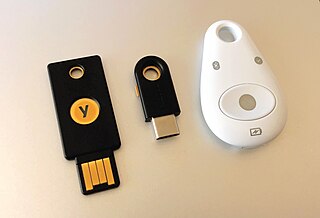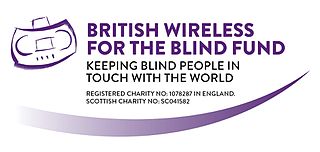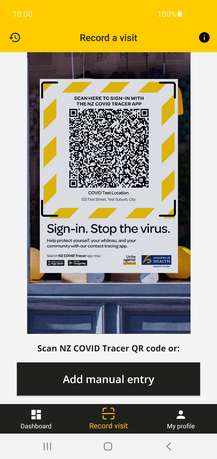Related Research Articles

Braille is a tactile writing system used by people who are visually impaired. It can be read either on embossed paper or by using refreshable braille displays that connect to computers and smartphone devices. Braille can be written using a slate and stylus, a braille writer, an electronic braille notetaker or with the use of a computer connected to a braille embosser.

A barcode or bar code is a method of representing data in a visual, machine-readable form. Initially, barcodes represented data by varying the widths, spacings and sizes of parallel lines. These barcodes, now commonly referred to as linear or one-dimensional (1D), can be scanned by special optical scanners, called barcode readers, of which there are several types.

A barcode reader or barcode scanner is an optical scanner that can read printed barcodes, decode the data contained in the barcode on a computer. Like a flatbed scanner, it consists of a light source, a lens, and a light sensor for translating optical impulses into electrical signals. Additionally, nearly all barcode readers contain decoder circuitry that can analyse the barcode's image data provided by the sensor and send the barcode's content to the scanner's output port.
The Royal National Institute of Blind People (RNIB) is a UK charity offering information, support and advice to almost two million people in the UK with sight loss. The charity affords practical and emotional support to those affected by sight issues and acts as an advocacy body.

Computer accessibility refers to the accessibility of a computer system to all people, regardless of disability type or severity of impairment. The term accessibility is most often used in reference to specialized hardware or software, or a combination of both, designed to enable the use of a computer by a person with a disability or impairment.

A QR code is a type of two-dimensional matrix barcode, invented in 1994, by Japanese company Denso Wave for labelling automobile parts. A QR code consists of black squares arranged in a square grid on a white background, including some fiducial markers, which can be read by an imaging device, such as a camera, and processed using Reed–Solomon error correction until the image can be appropriately interpreted. The required data are then extracted from patterns that are present in both the horizontal and the vertical components of the QR image.

Since the Global Positioning System (GPS) was introduced in the late 1980s there have been many attempts to integrate it into a navigation-assistance system for blind and visually impaired people.

NonVisual Desktop Access (NVDA) is a free and open-source, portable screen reader for Microsoft Windows. The project was started by Michael Curran in 2006.
Mobile tagging is the process of providing data read from tags for display on mobile devices, commonly encoded in a two-dimensional barcode, using the camera of a camera phone as the reader device. The contents of the tag code is usually a URL for information addressed and accessible through Internet.

Multi-factor authentication is an electronic authentication method in which a user is granted access to a website or application only after successfully presenting two or more pieces of evidence to an authentication mechanism. MFA protects personal data—which may include personal identification or financial assets—from being accessed by an unauthorized third party that may have been able to discover, for example, a single password.

Brand protection is the process and set of actions that a right holder undertakes to prevent third parties from using its intellectual property without permission, as this may cause loss of revenue and, usually more importantly, destroys brand equity, reputation and trust. Brand protection seeks primarily to ensure that trademarks, patents, and copyrights are respected, though other intellectual property rights such as industrial design rights or trade dress can be involved. Counterfeiting is the umbrella term to designate infringements to intellectual property, with the exception of the term piracy which is sometimes (colloquially) used to refer to copyright infringement.
The terms active packaging, intelligent packaging, and smart packaging refer to amplified packaging systems used with foods, pharmaceuticals, and several other types of products. They help extend shelf life, monitor freshness, display information on quality, improve safety, and improve convenience.
The Norwegian Library of Talking Books and Braille is a public library organization based in Oslo, Norway. It produces and loans out audiobooks and braille books. Its services are aimed at people who have difficulty reading printed texts, for example because of dyslexia, visual impairment or other disabilities which making reading difficult. The library serves users across the whole country and the service is free of charge. Audiobooks are sent free by post on CD and can also be downloaded or streamed from the library's website. Users can also use the library's Lydhør app to listen to audiobooks on smartphones or tablets. The library is Norway's largest producers of audiobooks and braille books. In 2014, its collection was made up of 18,000 audiobooks and 7400 braille books. The library also produces and loans out study materials for students with difficulties reading printed texts. Norwegian law permits the library to produce audio books and braille books from material subject to copyright. The library has about 29,000 users.

Google Now was a feature of Google Search of the Google app for Android and iOS. Google Now proactively delivered information to users to predict information they might need in the form of informational cards. Google Now branding is no longer used, but the functionality continues in the Google app and its discover tab.
Alternative formats include audio, braille, electronic or large print versions of standard print such as educational material, textbooks, information leaflets, and even people's personal bills and letters. Alternative formats are created to help people who are blind or visually impaired to gain access to information either by sight, by hearing (audio) or by touch (braille).

British Wireless for the Blind Fund (BWBF) is a British charity and a private company limited by guarantee. Founded by Sir Ernest Beachcroft Beckwith Towse in 1928, the organisation provides adapted radios and audio players on free loan to registered blind and partially sighted UK residents over the age of eight, where hardship circumstances can be demonstrated by receipt of a means-tested benefit.
Accessibility apps are mobile apps that increase the accessibility of a device for individuals with disabilities. Accessibility apps are applications that increase the accessibility of a device or technology for individuals with disabilities. Applications, also known as, application software, are programs that are designed for end users to be able to perform specific tasks. There are many different types of apps, some examples include, word processors, web browsers, media players, console games, photo editors, accounting applications and flight simulators. Accessibility in general refers to making the design of products and environment more accommodating to those with disabilities. Accessibility apps can also include making a current version of software or hardware more accessible by adding features. Accessibility apps main aim is to remove any barriers to technological goods and services, making the app available to any group of society to use. A basic example is that a person who experiences vision impairments is able to access technology through enabling voice recognition and text-to-speech software. Accessibility apps are closely related to assistive technology.
QR code payment is a contactless payment method where payment is performed by scanning a QR code from a mobile app. This is an alternative to doing electronic funds transfer at point of sale using a payment terminal. This avoids a lot of the infrastructure traditionally associated with electronic payments such as payment cards, payment networks, payment terminal and merchant accounts.

Scantrust is a Swiss company that provides an Internet of things platform for identifying products on the internet.

NZ COVID Tracer is a mobile software application that enables a person to record places they have visited, in order to facilitate tracing who may have been in contact with a person infected with the COVID-19 virus. The app allows users to scan official QR codes at the premises of businesses and other organisations they visit, to create a digital diary. It was launched by New Zealand's Ministry of Health on 20 May 2020, during the ongoing COVID-19 pandemic. It can be downloaded from the App Store and Google Play.
References
- 1 2 Barton, Alex (2023-03-23). "Persil adds QR codes to packaging for visually impaired shoppers". The Grocer . Retrieved 2024-04-08.
- 1 2 3 4 Fink, Charlie (2023-04-04). "Accessible QR Code From Zappar Makes Packaging Talk To The Blind". Forbes . Retrieved 2024-04-08.
- ↑ "Zappar make the case for accessible QR codes". Packaging Europe. 2023-08-18. Retrieved 2024-04-08.
- ↑ Murphy, David (2023-10-16). "Bayer Consumer Health UK launches "world's first" Accessible QR code in healthcare". Mobile Marketing. Retrieved 2024-04-08.